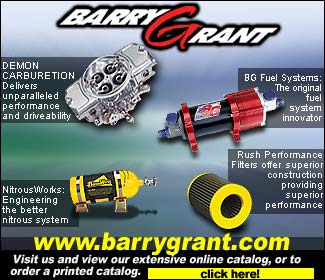|

Kenny’s first comment was in regards to a previous
interview in which he was asked how much horsepower a 600CI
turbo combination could make. The answer he gave the interviewer
was 4000HP based on having two turbo chargers that were capable
of supporting enough air to make 2000HP each. He went on
to say that was a theoretical estimation and in reality the
best he’s ever seen was "in the neighborhood of
3000HP and change."
Duttweiler also said that there are very few people with
dynos capable of measuring that kind of power. I asked Duttweiler
how he felt about the turbos being invited to join the ranks
of Pro Modifieds, in 2005 and his reply was "It’s
a welcome invitation to have and I hope to see the turbo combinations do well
and that ‘we’ don’t embarrass ourselves."
"Right now, there isn’t the ability to make these cars predictable
like you can with a blower or N2O combination," Duttweiler continued. "The
people that are running these types of combinations haven’t gotten enough
data and laps to see what the real potential is but
ADVERTISEMENT
 |
when they do, the sanctioning
body will have to look at the results and adjust the rules accordingly. I think
it’ll take 2 or 3 events for them to get where they’ll be competitive
with the other combinations."
Duttweiler went on to say that the real performance gains were going to
have to be on the first half of the track (especially before 330’).
He made a reference to the current crop of Nitro cars in which they have
more HP then they can physically put to the ground.
"It’s the guys that best manage that power that usually win the race." He
said this would be no different as it would appear at this juncture the turbo
combinations appear to make more power then the blown or nitrous cars.
Duttweiler also said he is a big fan of how a blown car manages power. "Unlike
a turbo car where horsepower is un-related to specific engine speed, the blown
car boost is directly tied to engine RPM which usually goes in conjunction
with ground speed. The only place the blower car drops boost is on the
gear changes. Boost management systems are critical in making the turbo
cars competitive."
Duttweiler also commented on the fan appeal of the turbo cars. "Every time
I’ve gone to the track, the turbo cars seem to be pretty popular and
usually many people gather to see what all the fuss is about."
Proof for that lies in Hurley Blakeney's “Silent Thunder” which
ran a Duttweiler-prepared small block in NHRA Competition Eliminator class
that was one of the most popular cars to run the class at the time and
is still one of the most easily recalled.
In the end it’s all about going back to the roots of Pro Modified which
was "run whatchya brung, and hope you brung enough." Of course there’s
always been safety considerations and other restrictions, but in the last few
years it appears that Pro Modified has stagnated due to desire to maintain
parity between the Nitrous and Blower combinations. It looks to be the goal
of TLR/AMS to change all that.
|

